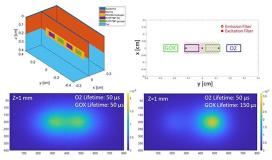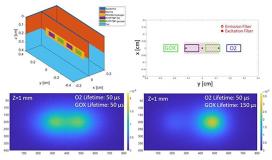Engineering Advances for Personalized Diabetes Treatment
Simulation techniques developed and applied by researchers at Texas A&M University (TAMU) are enabling advancements in implantable devices for glucose monitoring, the essential tool for managing diabetes. This research is part of an initiative to advance implantable sensor technology, which is supported by the NSF-funded Precise Advanced Technologies and Health Systems for Underserved Populations (PATHS-UP) Engineering Research Center (ERC), headquartered at TAMU, with partners from the University of California at Los Angeles, Rice University, and Florida International University.
Developing revolutionary and cost-effective implantable and wearable technologies and systems for personalized healthcare is the overarching goal of PATHS-UP. In this project, a soft polymeric device the size of a grain of rice is being developed as an implantable “barcode” sensor. In this case, a prototype with four internal compartments was designed to contain optical indicators to measure glucose and oxygen. The researchers used a computerized mathematical approach known as Monte Carlo-based light simulation to create a model that accurately reflects the optical properties of the implanted multi-element glucose and oxygen barcode sensor and surrounding tissue. This approach is enabling a better understanding of sensor performance in different tissue environments, particularly those that vary with skin tone, as is often seen in diverse populations.
Computational modeling is a significant component of device design. Functionality and optimization of various parameters can be performed rapidly and without extensive use of resources. In this case, for the implantable system, optimization of parameters such as implant shape/size, incident wavelength, source-detector configuration, and analysis of chemical diffusion can occur to maximize performance within given constraints. Specifically, Monte Carlo simulation allows researchers to build models of possible results by substituting a range of values—a probability distribution—for any factor that has inherent uncertainty. In this case the factor is the propagation of light in scattering and absorbing tissue; and the model calculates results over and over, each time using a different set of random values from the probability functions. Depending upon the number of uncertainties and the ranges specified for them, a Monte Carlo simulation could involve thousands or tens of thousands of recalculations before it is complete. Applying this technique to optical light propagation for glucose and oxygen monitoring technology enabled researchers to consider many variables and different probabilities of different outcomes occurring. Probability distributions are a much more realistic way of describing uncertainty in variables of a risk analysis.




